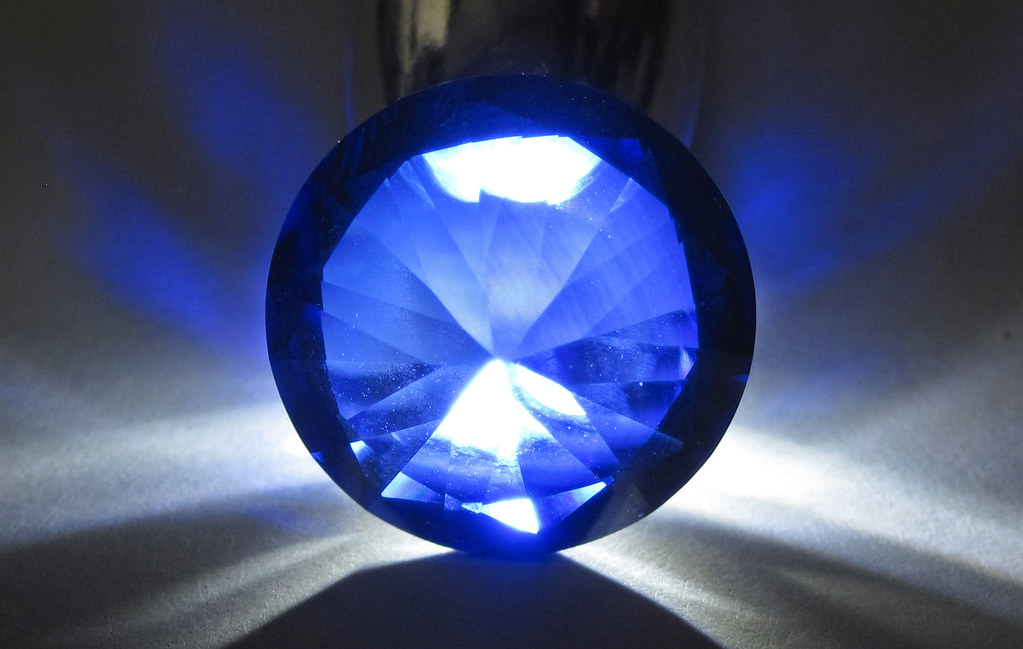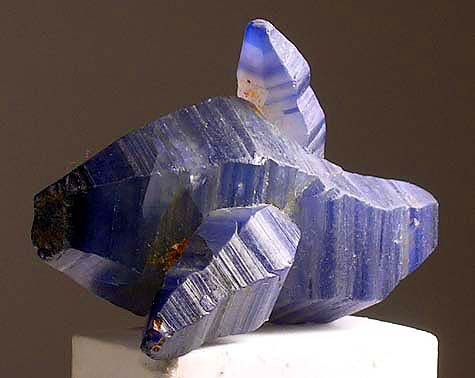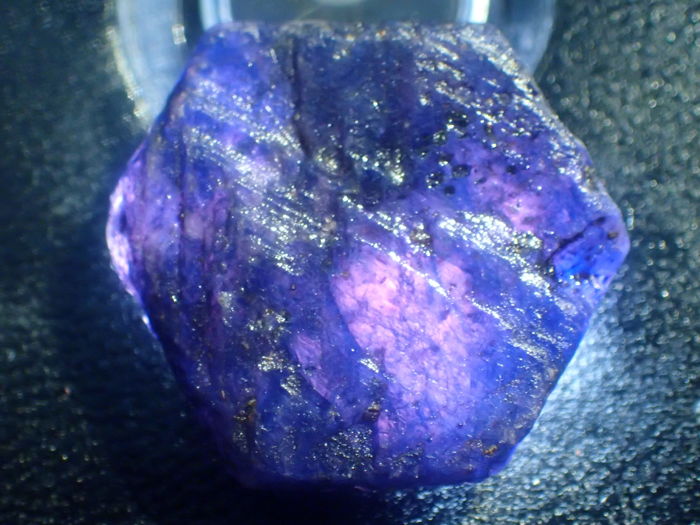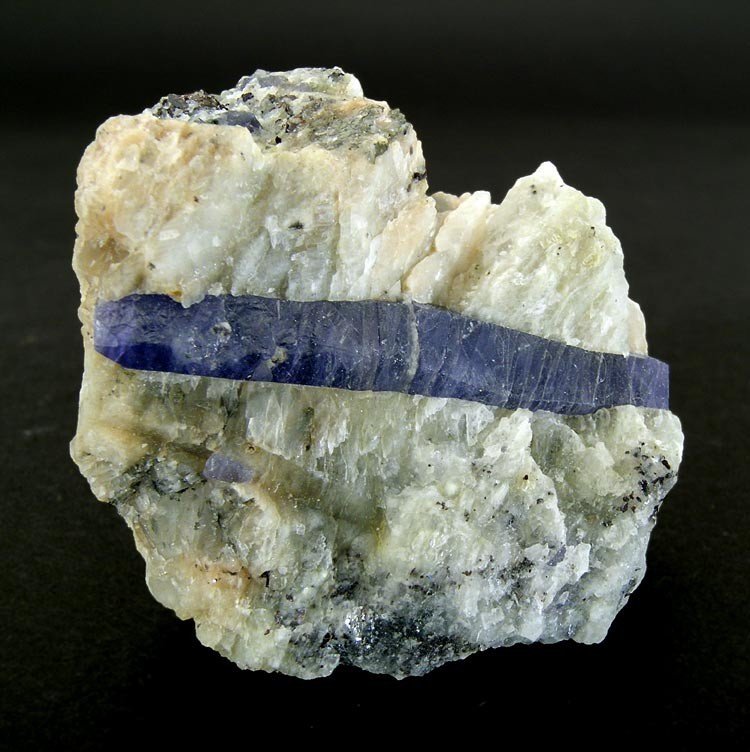No one is exactly sure how long-ago sapphire gemstones were formed. But we do know that the sapphires which are found today were formed around 150 to 200 million years ago. Today the modern location of sapphires gives us some clues and indications about the place of their formation and how they are created as jewellery worn by people.
The Origin of Sapphire Gemstones
The word Sapphire comes from the Greek “Sapphires”, which means blue. These are the blue gemstones most often seen in jewellery, with colours ranging from pale, ice blue to deep, cobalt blue, but did you know that sapphires also come in other colours?
Blue is just the more highly prized variant of the mineral corundum. Sapphires also come in orange-pink, golden, white, and even black. The natural crystal form of sapphire is called a trigonal (three-sided prisms).
Some more interesting varieties of sapphire with rutile (the ore form of titanium) intrusions cause light to be reflected in a six-point star, creating what is known as a star sapphire. This star-shaped effect is known as an asterism and is a less pure form of sapphire.
Thus, all colours of the translucent form of the mineral corundum are known as sapphires. The main deposits of high-quality sapphire gemstones are found only in a few places, mainly in southern Asia and eastern Africa and the islands of Sri Lanka (Ceylon) and Madagascar.
How are Sapphire Gemstones Formed?
The answer as to what took place inside the earth to form these gems and then transport them to the surface varies from country to country, but the story remains the same. At some point, millions of years ago, source rocks inside the earth’s crust were subjected to intense pressures and high temperatures, causing the atoms to recombine into new metamorphic (changed) rocks which included rubies and sapphires (corundum).
The details change in each country. Some Sapphire gemstones are found in high-grade metamorphic rocks and in igneous rocks, called gneisses and granulites, located in Australia, Sri Lanka, India, Madagascar, and Eastern Africa. In most cases, they formed at depths of 6–18 miles in the earth’s crust, as intense pressures and high temperatures above 800 degrees transformed sedimentary (“water deposited”) rocks, such as siltstones and shale.
Geologic Formation
Sapphires, like any naturally occurring gemstone, are formed by the different shifts, mixings and chemical changes that are constantly taking place in the earth. Then, Sapphire gemstones are created through certain shifts in heat and pressure and can be found in both metamorphic and igneous rocks.
Rocks in which sapphires can be found include granite, schist, gneiss, nepheline syenite and a variety of others. They may also be found in deposits of alluvium. When Sapphires are formed naturally, they are hexagonal and are called corundum. Due to the remarkable hardness of sapphires, second only to diamonds, they are highly prized.
Colouring
Corundum can be found in a variety of colours; however, it is only considered to be a Sapphire when it is not red. Red corundum is referred to as a Ruby. During the formation of corundum, the colouring of the stone is dependent upon what minerals are present.
For instance, when the iron is present, sapphires may have a green or yellow hue to them, whereas the presence of vanadium will create purple sapphires. The most prized sapphires are blue, which is a result of titanium being present when the stone is formed.
Artificial Sapphires
With advances in science and technology, methods have been created for artificially growing sapphire crystals. The original process was discovered in 1902, and it consisted of alumina powder being added to an oxyhydrogen flame, which is in turn directed downward.
Alumina in this flame is slowly “deposited” in a teardrop shape called a boule. A variety of chemicals can be added throughout this process to create sapphires of multiple hues, as well as red rubies.
While other processes have been discovered since the early 1900s, it is these artificial sapphire gemstones that have opened up the use of the stone for technological purposes, including use in panes of glass, and as focusing devices in lasers.
Understanding the Sapphire Gemstones and Its Characteristics
In this section of our education on sapphires, we start with the very basics of sapphire gemstones and their characteristics. The more information you understand about these stones the more you will appreciate them.
If you have a general interest in sapphires or if you plan to purchase one from Opals Down Under (only stocking Australian Sapphires); this section will give you a comprehensive insight into the beautiful world of sapphires!
The Sapphire Crystal
The scientific name of a sapphire crystal is called Corundum. A sapphire (corundum) is an aluminium oxide mineral (Al2O3). Its crystal structure is hexagonal.
Corundum (sapphires) comes in all colour types. Blue Corundum is called Blue Sapphire; Pink Corundum is called Pink Sapphire, etc. Trace mineral content within the crystal gives it colour (further details on colour explained in each specific sapphire type).
Hardness
Corundum is an exceptionally hard crystal structure. The only crystal harder than Corundum (sapphire) is a diamond (cubic crystal structure).
Sapphires are a 9 on the Mohs hardness scale. The Mohs scale was developed by Friedrich Mohs in 1812 and has been a valuable aid in identifying minerals ever since. Here are the ten levels of hardness in minerals on the scale:
- Talc (chalk)
- Gypsum
- Calcite
- Fluorite
- Apatite
- Feldspar
- Opal
- Quartz (Amethyst, Citrine)
- Topaz (Precious topaz, blue topaz)
- Corundum (SAPPHIRES)
- Diamond
The Mohs scale is strictly relative, but that’s all anyone needs for basic hardness measurement.
Because it isn’t made for that kind of precision, the Mohs scale uses half-numbers for in-between hardness. Sapphire is an incredibly hard and durable crystal (9/10).
Refractive Index
One way to identify a crystal species is by taking a refractive index test. The Refractive index is the reading of how a crystal separates the spectrum of light. Each crystal structure will separate light differently and this is one reliable method to identify a crystal structure.
A refractive index test on a pink, blue, yellow or green sapphire will give the same refractive index reading. The wide range of colours of sapphires will not influence refractive index readings. The test only identifies the crystal, not the colouration of the crystal as viewed by the human eye.
The Refractive index for Corundum (Sapphire) is 1.75 – 1.76
Colours
Sapphires come in all ranges of colours from blue to black to colourless and all colours in between. There are no limits to the colour tone or saturation of colour in a sapphire. How sapphires have different colours is through the trace mineral content within a sapphire crystal.
A blue sapphire will reflect blue light because the crystal has a titanium element within the stone. If a sapphire has other trace minerals such as chromium, then the stone will be pink in colour.
Therefore, if a combination of elements is within the stone, you might have lime green or a purplish-blue sapphire. A chemically pure sapphire crystal would be colourless. Whatever ingredients nature puts in a sapphire is what special unique colour it will show.
For this reason, sapphires are extraordinarily unique from one to the next. No two are exactly the same; rare and unusual sapphires are almost irreplaceable, even one that is only 1 or 2 carats in size.
Size
Sapphires come in all sizes. They are readily available under 1ct and can come as large as 20+cts in fine quality, but these stones are exceptionally rare. Specimen grade sapphire can come in huge sizes of thousands of carats, but this material has little or no value at all.
Untreated vs. Treated
In very short detail, an untreated sapphire has been taken from the ground in which it came and faceted. Nothing at all was done to the stone to alter the natural beauty which only the earth created naturally.
These sapphires are exceptionally rarer and more valuable. For this reason, sapphires are extraordinarily unique from one to the next. No two are exactly the same; rare and unusual sapphires are almost irreplaceable, even one that is only 1 or 2 carats in size.
Rarity
Rarity means that something cannot be replaced easily. When something is rare and market demand is present, naturally prices will rise. The market for untreated sapphires has continued to rise as more and more consumers become more aware of the treatment of conventional sapphires in the marketplace.
Sapphires of fine quality are very rare. Diamonds, for example, are in almost every type of jewellery, in every jewellery store, and on websites around the world.
The world production and use of diamonds prove that diamonds are not at all rare, and are in extraordinary supply. Prices are held up by a combination of highly inflated profit margins as well as controlled release of supply reserves by the diamond cartels.
Sapphires are mined heavily in gem producing countries, by traditional and mechanical methods. Even with heavy mining, the rate of return on fine sapphires is exponentially less than the production and availability of most other gemstones. For this reason, specifically natural untreated sapphires are a safe investment for retaining and attaining long term value.
In the case of natural untreated sapphires, rarity represents opportunity.
Origins of Sapphires
Sapphires come from many places around the world but few locations produce fine qualities. Based from Opal Down Under‘s study and years of experience, the most beautiful sapphires come from the same countries as they have for thousands of years. Only a few new deposits have been discovered in recent times.
Sri Lanka (Ceylon) & Madagascar
The most notable producer of fine blue sapphires is Sri Lanka or “Ceylon” as referred to within the trade (Ceylon was the former name of the country. It has only recently changed to “Sri Lanka” since gaining independence from the British).
The quantity and quality of blue sapphires coming from Sri Lanka are only rivalled by new deposits found in Madagascar. The sapphires from Madagascar are in many cases almost indistinguishable from sapphires from Sri Lanka.
The colour tone and internal crystal characteristics of Madagascar and Ceylon sapphires are almost identical in most cases. The prices for blue sapphires from both countries are similar.
Burma and Origins
Burma (now called Myanmar since gaining independence from the British) is another long time producing country of fine blue sapphires. Usually, Burmese sapphires are described as royal blue, typically on the darker side of royal blue.
Many gemologists, retailers, auctioneers, and other stone houses will talk very highly of Burmese sapphires being the very best quality sapphires. We do not necessarily agree that this is true and fair.
Each sapphire should be graded by its visual appearance for sheer beauty. Burma does produce excellent stones, usually in smaller quantities but larger sizes. Burmese sapphires will almost always cost 50% – 100% more than a sapphire from Madagascar or Ceylon.
Kashmir
“Kashmir” sapphires are talked about in almost a mythical way these days. Kashmir sapphires were found in a very remote mountainous region of India in the late 1800s. The stones were in most cases exceptionally fine quality. The colour tone term “cornflower blue” was coined from these stones.
The term is generally described as “velvety” or “sleepy” being that the colour is very soothing and appealing. The deposit was exhausted by the 1920s and there have been no new finds in the Kashmir area.
For this reason, the prices of Kashmir sapphires have been widely valued. Prices can be 10 times the cost of a comparable blue sapphire from another country.
Other Producing Locations:
Other countries producing blue sapphires such as Thailand, Tanzania, Australia, Montana (USA), and Cambodia do produce sizable quantities.
They are generally viable for commercial jewellery use only. They do produce fine rare sapphires on the occasion that can be expensive, but this is not reliable production. Most blue sapphires coming from these locations normally have secondary colour tones and need to be treated to be saleable.
The Value of Sapphire Gemstone with Opals Down Under
Ultimately, no gemstone on earth is as unique or mesmerising as sapphires and opals. Opals Down Under has a full range of both Unset Sapphire and contemporary and traditional jewellery settings, designed, selected and crafted to suit your unique taste and budget. Our expert award-winning jewellers specialise in crafting quality opal and sapphire settings.





